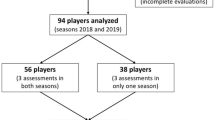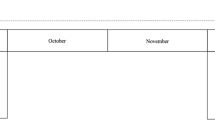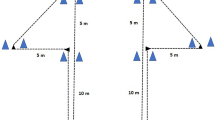Abstract
Purpose
This 11-week study aimed to correlate the neuromuscular profile and the total volume of resisted sprint training (RST) under different velocity loss (VL) magnitudes in male professional soccer players.
Methods
Seventeen soccer players (age 25.8 ± 4.3 years; height 180.0 ± 8.6 cm; weight 77.7 ± 9.7 kg) were randomly allocated into two training groups, who trained at distinct percentages of VL: 10% of VL (G10, n = 8) or 20% of VL (G20, n = 9). The velocity-based sled training consisted of 20 m resisted sprints executed with a progressive loading increase (45–65% of body-mass). Sprint times (10 m and 20 m), vertical jump height [countermovement jump (CMJ) and squat jump (SJ)], knee flexion and extension peak torque, as well as isometric rate of torque development, and lower limb lean mass were correlated with the total volume of RST performed by G10 and G20 groups.
Results
The G10 performed 31% less repetitions and total RST distance than G20 (p = 0.002). Significant negative Pearson’s correlations (large-to-very large) were observed between total volume performed by G10 and CMJ height [r = − 0.85, confidence interval at 95% (95% CI) = − 0.98 to − 0.58, p = 0.02, Cohen’s D effect size (ES) = 0.41] as well as SJ height (r = − 0.90, 95% CI − 0.99 to − 0.66, p = 0.005, ES = 0.80), and knee extension concentric peak torque (r = − 0.69, 95% CI − 0.99 0.91, p = 0.05, ES = 0.03). No further correlation was found (p > 0.05).
Conclusions
When lower magnitudes of VL were used during training sessions (10%), the stronger and more powerful players performed lower volume of RST. Interestingly, this relationship is not confirmed when higher magnitudes of VL (20%) are prescribed (greater fatigue incidence).



Similar content being viewed by others
References
Alcaraz PE, Carlos-Vivas J, Oponjuru BO, Martínez-Rodríguez A (2018) The effectiveness of resisted sled training (RST) for sprint performance: a systematic review and meta-analysis [published correction appears in Sports Med. Sports Med 48(9):2143–2165. https://doi.org/10.1007/s40279-018-0947-8
Barnes C, Archer DT, Hogg B, Bush M, Bradley PS (2014) The evolution of physical and technical performance parameters in the English Premier League. Int J Sports Med 35(13):1095–1100. https://doi.org/10.1055/s-0034-1375695
Cahill MJ, Oliver JL, Cronin JB, Clark KP, Cross MR, Lloyd RS (2019) Sled-pull load-velocity profiling and implications for sprint training prescription in young male athletes. Sports (Basel) 7(5):119. https://doi.org/10.3390/sports7050119
Grazioli R, Loturco I, Lopez P, Setuain I, Goulart J, Veeck F et al (2020) Effects of moderate-to-heavy sled training using different magnitudes of velocity loss in professional soccer players. J Strength Cond Res. https://doi.org/10.1519/JSC.0000000000003813
Loturco I, Kobal R, Kitamura K, Cal Abad CC, Faust B, Almeida L et al (2017) Mixed training methods: effects of combining resisted sprints or plyometrics with optimum power loads on sprint and agility performance in professional soccer players. Front Physiol 12(8):1034. https://doi.org/10.3389/fphys.2017.01034
Alcaraz PE, Carlos-Vivas J, Oponjuru BO, Martínez-Rodríguez A (2019) Authors’ Reply to Cross et al Comment on: The effectiveness of resisted sled training (RST) for sprint performance: a systematic review and meta-analysis. Sports Med 49(2):353–356. https://doi.org/10.1007/s40279-018-01037-x
Cross MR, Brughelli M, Samozino P, Brown SR, Morin JB (2017) Optimal loading for maximizing power during sled-resisted sprinting. Int J Sports Physiol Perform 12(8):1069–1077. https://doi.org/10.1123/ijspp.2016-0362
Cross MR, Samozino P, Brown SR, Lahti J, Jimenez-Reyes P, Morin JB (2019) Comment on: “The Effectiveness of resisted sled training (RST) for sprint performance: a systematic review and meta-analysis.” Sports Med 49(2):349–351. https://doi.org/10.1007/s40279-018-01038-w
Morin JB, Petrakos G, Jiménez-Reyes P, Brown SR, Samozino P, Cross MR (2017) Very-heavy sled training for improving horizontal-force output in soccer players. Int J Sports Physiol Perform 12(6):840–844. https://doi.org/10.1123/ijspp.2016-0444
Petrakos G, Morin JB, Egan B (2016) Resisted sled sprint training to improve sprint performance: a systematic review. Sports Med 46(3):381–400. https://doi.org/10.1007/s40279-015-0422-8
Lizana JA, Bachero-Mena B, Calvo-Lluch A, Sánchez-Moreno M, Pereira LA, Loturco I et al (2020) Do faster, stronger, and more powerful athletes perform better in resisted sprints? J Strength Cond Res. https://doi.org/10.1519/JSC.0000000000003719
Loturco I, Jeffreys I, Kobal R, Reis VP, Fernandes V, Rossetti M et al (2020) Resisted sprint velocity in female soccer players: influence of physical capacities. Int J Sports Med 41(6):391–397. https://doi.org/10.1055/a-1083-6724
Pareja-Blanco F, Rodríguez-Rosell D, Sánchez-Medina L, Sanchis-Moysi J, Dorado C, Mora-Custodio R et al (2017) Effects of velocity loss during resistance training on athletic performance, strength gains and muscle adaptations. Scand J Med Sci Sports 27(7):724–735. https://doi.org/10.1111/sms.13967
Barreira TV, Tseh W (2020) The effects of acute water ingestion on body composition analyses via dual-energy X-ray absorptiometry. Clin Nutr 39(12):3836–3838. https://doi.org/10.1016/j.clnu.2020.03.037
Bosco C, Rusko H (1983) The effect of prolonged skeletal muscle stretch-shortening cycle on recoil of elastic energy and on energy expenditure. Acta Physiol Scand 119(3):219–224. https://doi.org/10.1111/j.1748-1716.1983.tb07331.x
Cadore EL, Pinheiro E, Izquierdo M, Correa CS, Radaelli R, Martins JB et al (2013) Neuromuscular, hormonal, and metabolic responses to different plyometric training volumes in rugby players. J Strength Cond Res 27(11):3001–3010. https://doi.org/10.1519/JSC.0b013e31828c32de
Grazioli R, Lopez P, Andersen LL, Machado CLF, Pinto MD, Cadore EL et al (2019) Hamstring rate of torque development is more affected than maximal voluntary contraction after a professional soccer match. Eur J Sport Sci 19(10):1336–1341. https://doi.org/10.1080/17461391.2019.1620863
Maffiuletti NA, Aagaard P, Blazevich AJ, Folland J, Tillin N, Duchateau J (2016) Rate of force development: physiological and methodological considerations. Eur J Appl Physiol 116(6):1091–1116. https://doi.org/10.1007/s00421-016-3346-6
Sahaly R, Vandewalle H, Driss T, Monod H (2001) Maximal voluntary force and rate of force development in humans—importance of instruction. Eur J Appl Physiol 85(3–4):345–350. https://doi.org/10.1007/s004210100451
Cross MR, Tinwala F, Lenetsky S, Samozino P, Brughelli M, Morin JB (2017) Determining friction and effective loading for sled sprinting. J Sports Sci 35(22):2198–2203. https://doi.org/10.1080/02640414.2016.1261178
Hopkins WG, Marshall SW, Batterham AM, Hanin J (2009) Progressive statistics for studies in sports medicine and exercise science. Med Sci Sports Exerc 41(1):3–13. https://doi.org/10.1249/MSS.0b013e31818cb278
Martínez-Valencia MA, González-Ravé JM, Santos-García DJ, Alcaraz Ramón PE, Navarro-Valdivielso F (2014) Interrelationships between different loads in resisted sprints, half-squat 1 RM and kinematic variables in trained athletes. Eur J Sport Sci 14:S18-24. https://doi.org/10.1080/17461391.2011.638935
Walker S (2019) Neural adaptations to strength training. In: Schumann M, Rønnestad B (eds) Concurrent aerobic and strength training. Springer, Cham, pp 75–86
Allen DG, Lännergren J, Westerblad H (1995) Muscle cell function during prolonged activity: cellular mechanisms of fatigue. Exp Physiol 80(4):497–527. https://doi.org/10.1113/expphysiol.1995.sp003864
Gorostiaga EM, Navarro-Amézqueta I, Calbet JA, Hellsten Y, Cusso R, Guerrero M et al (2012) Energy metabolism during repeated sets of leg press exercise leading to failure or not. PLoS ONE 7(7):e40621. https://doi.org/10.1371/journal.pone.0040621
Potach D (2004) Plyometrics and speed training. In: National Strength and Conditioning Association (NSCA)'s essentials of personal training, 1st edn, chap 17. Human Kinetics, pp 425–458
Sánchez-Medina L, González-Badillo JJ (2011) Velocity loss as an indicator of neuromuscular fatigue during resistance training. Med Sci Sports Exerc 43(9):1725–1734. https://doi.org/10.1249/MSS.0b013e318213f880
Acknowledgements
We thank to CAPES and CNPq Brazilian Government Associations for its support to this project. We also thank to Strength Training Research Group of Federal University of Rio Grande do Sul and High-Performance Nucleus of São Paulo for the technical support, all the athletes, and the club who participated in this research and made it possible.
Author information
Authors and Affiliations
Contributions
RG, IL, and EC have given substantial contributions to data acquisition and analysis, manuscript writing and revision, FV and MI to data acquisition and analysis, RR, JT, RP, and IG to manuscript writing and revision. All authors read and approved the final version of the manuscript.
Corresponding author
Ethics declarations
Conflict of interest
No potential conflict of interest was reported by the authors.
Ethical approval
All the procedures performed in studies involving human participants were in accordance with the ethical standards of the institutional and/or national research committee and with the 1964 Helsinki Declaration and its later amendments or comparable ethical standards. This article does not contain any studies with animals performed by any of the authors. The present study was evaluated and approved by the Federal University of Rio Grande do Sul’s Ethics and Research Committee under number 2.622.456.
Informed consent
The participants were informed about the research procedures and invited to read and sign the informed consent form if they agreed. Informed consent was obtained from all the individual participants included in the study.
Additional information
Publisher's Note
Springer Nature remains neutral with regard to jurisdictional claims in published maps and institutional affiliations.
Rights and permissions
Springer Nature or its licensor holds exclusive rights to this article under a publishing agreement with the author(s) or other rightsholder(s); author self-archiving of the accepted manuscript version of this article is solely governed by the terms of such publishing agreement and applicable law.
About this article
Cite this article
Grazioli, R., Loturco, I., Veeck, F. et al. Relationship between neuromuscular profile and total volume of resisted sprint training in male professional soccer players. Sport Sci Health 19, 1119–1127 (2023). https://doi.org/10.1007/s11332-022-00998-x
Received:
Accepted:
Published:
Issue Date:
DOI: https://doi.org/10.1007/s11332-022-00998-x




